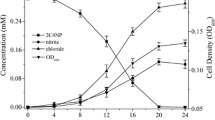Abstract
A bacterium capable of utilizing pyrethroid pesticide cypermethrin as sole source of carbon was isolated from soil and identified as a Micrococcus sp. The organism also utilized fenvalerate, deltamethrin, perimethrin, 3-phenoxybenzoate, phenol, protocatechuate and catechol as growth substrates. The organism degraded cypermethrin by hydrolysis of ester linkage to yield 3-phenoxybenzoate, leading to loss of its insecticidal activity. 3-Phenoxybenzoate was further metabolized by diphenyl ether cleavage to yield protocatechuate and phenol as evidenced by isolation and identification of metabolites and enzyme activities in the cell-free extracts. Protocatechuate and phenol were oxidized by ortho-cleavage pathway. Thus, the organism was versatile in detoxification and complete mineralization of pyrethroid cypermethrin


Similar content being viewed by others
References
Bradbury SP, Coats JR (1989) Toxicokinetics and toxicodynamics of pyrethroid insecticides in fish. Environ Toxicol Chem 8:373–380
Halden UR, Peters EG, Halden BG, Dwyer FD (2000) Transformation of mono- and dichlorinated phenoxybenzoate-dioxygenase in Pseudomonas pseudoalcaligenes POB310 and a modified diarylether- metabolizing bacterium. Biotechnol Bioengin 69:107–112
Halden UR, Tepp SM, Halden BG, Dwyer FD (1999) Degradation of 3- phenoxybenzoic acid in soil by Pseudomonas pseudoalcaligenes POB310 (pP0B) and two modified Pseudomonas strains
Hayaishi O, Katagiri M, Rothberg S (1957) Studies on oxygenases. Pyrocatechase. J Biol Chem 229:905–920
Holding AJ, Collee J G (1971) Routine biochemical tests. In: Norris JR, Ribbons DW (eds) Methods in Microbiology, vol 6A, P1. Academic press: London and New York, ISBN 0-12-521506-1
Holt JG (ed) (1993) Bergrey’s manual of determinative bacteriology, 9th edn. The Williams & Wilkins, Baltimore
Kaufman DD, Russell BA, Helling CS, Kayser AJ (1981) Movement of cypermethrin, decamethrin, permethrin and their degradation products in soil. J Agric Food Chem 29:239–245
Kim Y, Choi BS, Lee JR, Chang HI, Min KR (1992) Characterization of catechol 2,3- dioxygenase. Biochem Biophys Res Commun 183:77–82
Lowry OH, Rosebrough NJ, Farr AL, Randall RJ (1951) Protein measurement with the Folin-phenol reagent. J Biol Chem 192:265–275
Mac Donold DL, Stanier RY, Ingrahm JL (1954) The enzymatic formation of β-Carboxymuconic acid. J Biol Chem 210:809–820
Maloney SE, Maule A, Smith ARW (1988) Microbial transformation of the pyrethroid insecticides: Permethrin, deltamethrin, fastac,fenvalerate and fluvalinate. Appl Environ Microbiol 54:2874–2876
Mandel M, Marmur J (1968) Use of UV absorbance temperature profile for determining the guanine plus cytosine contest of DNA. Methods Enzymol 12B:195–196
Murmur J (1961) A procedure for the isolation of deoxyribonucleic acid from microorganisms. J Molecular Biology 3:208
Neujahar HY, Gaal A (1973) Phenol hydroxylase from yeast. Purification and properties of the enzyme from Trichosporon cutancum. Eur J Biochem 35:386–400
Pelczar MJ (ed) (1957) Manual of microbiological methods. Mc Graw. Hill, New York
Roberts TR, Standen ME (1977) Degradation of the pyrethroid cypermethrin NRDC 149(+/−)-α-cyano-3-phenoxybenzyl(+/−)-cis,trans-3-(2,2-dichlorovinyl)-2,2-dimethylcyclopropane carboxylate and the respective cis-(NRDC 160) and trans-(NRDC 159) isomers in soils. Pest Sci 8:305–319
Roberts TR, Standen ME (1981) Further studies of the degradation of the pyrethroid insecticide cypermethrin in soils. Pest Sci 12:285–296
Seubert W (1960) Determination of isoprenoid compounds by microorganisms. Isolation and characterization of an isoprenoid degrading bacterium. Pseudomonas citronellolis, new species. J Bacteriol 79:426–434
Author information
Authors and Affiliations
Corresponding author
Rights and permissions
About this article
Cite this article
Tallur, P.N., Megadi, V.B. & Ninnekar, H.Z. Biodegradation of Cypermethrin by Micrococcus sp. strain CPN 1 . Biodegradation 19, 77–82 (2008). https://doi.org/10.1007/s10532-007-9116-8
Received:
Accepted:
Published:
Issue Date:
DOI: https://doi.org/10.1007/s10532-007-9116-8




